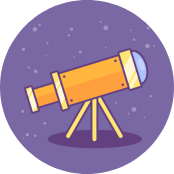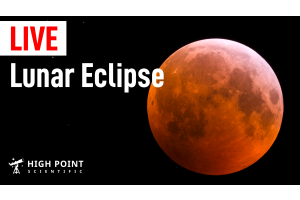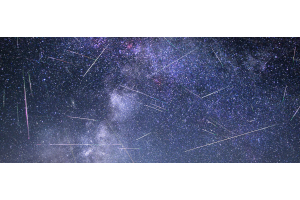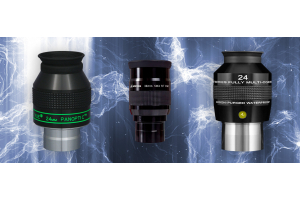
Eclipses are one of nature’s spectacles, and nothing rivals a total solar eclipse in terms of awe and splendor. However, observing the Sun without taking the proper precautions can be extremely dangerous, and even observing with just the naked eye can cause permanent damage.
You’ll need certified eclipse glasses to safely observe a solar eclipse; if you purchased your solar eclipse glasses from High Point Scientific, regardless of the brand, you can be assured that they are certified to be safe for solar viewing when used as directed. However, If you purchased your glasses from another vendor or were gifted a pair, you should always make sure they are safe to use by following the steps below.
Steps For Safely Viewing A Solar Eclipse
- Always inspect the lenses of the eclipse glasses before use. Look for scratches or other damage, and shine a dim flashlight through the lenses. If you see any light coming through the other side, these glasses are not safe to observe the Sun with.
- Ensure your glasses are ISO 12312-2 compliant, which is the international standard by which all eclipse glasses are manufactured. Beware of any glasses that only claim to be NASA-approved or something similar because unless they meet the ISO standard, they can’t be trusted to be safe. All solar eclipse glasses sold by High Point Scientific are ISO 12312-2 compliant.
- Make sure children keep their eclipse glasses on at all times and never let them look at the Sun without them. Monitor and assist your child should they have difficulty finding the Sun with the glasses.
- DO NOT LOOK AT THE SUN WITHOUT A PAIR OF ECLIPSE GLASSES. Doing so may cause permanent damage to your eyes and may even lead to blindness. You might not even realize your eyes are being damaged until sometime after the eclipse has ended and the issues begin.
- DO NOT LOOK AT THE SUN THROUGH A TELESCOPE OR BINOCULARS WITHOUT SOLAR FILTERS. This is far more damaging than staring at the Sun with just your eyes. Not only does the equipment magnify the image you see, but it also magnifies the heat. Like using a magnifying glass to burn a leaf, your eyes will suffer immediate and permanent damage.
- Do not attempt to create or improvise your own solar eclipse glasses or filters. ISO-certified solar eclipse glasses are manufactured to block many wavelengths of light, including ultraviolet light. You might think that welder’s glass is a good alternative, but since it’s only designed to block visible light, it will still allow ultraviolet light through - and this, in turn, will damage your eyes. Similarly, regular sunglasses - with or without UV protection - simply aren’t up to the job.
- The only safe time to remove your glasses is during totality. In fact, we strongly recommend that you do, as this is the most spectacular part of the eclipse, and you might not see anything otherwise! Totality typically lasts for a few minutes, and it’s recommended you learn how long totality will last for your location before the start of the eclipse. (You can get this information from timeanddate.com.) NOTE: You should never remove your glasses during an annular or partial eclipse.
- Make sure everyone in your party understands how to use their glasses. Children’s glasses should be checked to make sure they are being worn properly, and the children should be supervised by an adult at all times. We also recommend everyone in your party has their own pair of solar glasses since accidents are more likely to happen if people are sharing.
- Don’t use your solar glasses to look at the Sun prior to or following an eclipse. Eclipse glasses are designed to allow you to safely observe the Sun during a partial eclipse, when the Sun’s light is reduced, and your glasses may not work as efficiently when the sunlight is at full strength. At the very least, your eyes will be dazzled, and you may find it hard to see properly afterward.

Learn More
Looking for more advice on how to safely view a total solar eclipse? Our experts are ready to help! Fill out the “Contact Us” form, and we’ll answer any questions you may have.
Click the arrow above to see MLA, APA, and Chicago Manual of Style citations.
MLA:
High Point Scientific Team. "Viewing the Sun Safely with Solar Eclipse Glasses," AstronomyHub, High Point Scientific, 16 Oct. 2023, https://www.highpointscientific.com/astronomy-hub/post/viewing-the-sun-safely-with-solar-eclipse-glasses.
APA:
High Point Scientific Team. (2023, October 16). Viewing the sun safely with solar eclipse glasses. High Point Scientific. https://www.highpointscientific.com/astronomy-hub/post/viewing-the-sun-safely-with-solar-eclipse-glasses
Chicago Manual of Style:
Bibliography:
High Point Scientific Team. "Viewing the Sun Safely with Solar Eclipse Glasses," AstronomyHub (blog), High Point Scientific, October 16, 2023. https://www.highpointscientific.com/astronomy-hub/post/viewing-the-sun-safely-with-solar-eclipse-glasses.
Footnote:
High Point Scientific Team, "Viewing the Sun Safely with Solar Eclipse Glasses," AstronomyHub, High Point Scientific, October 16, 2023, https://www.highpointscientific.com/astronomy-hub/post/viewing-the-sun-safely-with-solar-eclipse-glasses.
This Article was Originally Published on 8/15/2017








